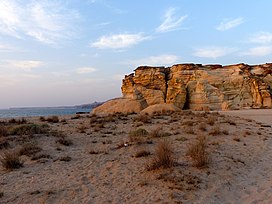Gulf of Oman desert and semi-desert
| Gulf of Oman desert and semi-desert | |
|---|---|
 | |
 Map of the ecoregion | |
| Ecology | |
| Realm | Afrotropical |
| Biome | deserts and xeric shrublands |
| Borders | |
| Geography | |
| Area | 62,420 km2 (24,100 sq mi) |
| Countries | |
| Conservation | |
| Conservation status | Critical/endangered[1] |
| Protected | 1.58%[2] |
The Gulf of Oman desert and semi-desert is a coastal ecoregion on the Persian Gulf and the Gulf of Oman in Oman and the United Arab Emirates at the northeastern tip of the Arabian Peninsula. The climate is hot and dry, with gravelly plains and savanna with thorny acacia trees inland from the coast. Along the coast there are mixture of habitats that include mangrove swamps, lagoons and mudflats. The mangrove areas are dominated by Avicennia marina and the savanna by Prosopis cineraria and Vachellia tortilis. Masirah Island is an important breeding area for the loggerhead sea turtle and other sea turtles also occur here, as well as a great variety of birds, some resident and some migratory. There are some protected areas, but in general the habitats have been degraded by the grazing of livestock, especially camels and goats; they are also at risk from oil spills, off-road driving and poaching.[3]
Location and description
In Oman this ecoregion includes the
This dry ecoregion contains a mixture of habitats including mangrove swamps, lagoons and mudflats on the coast, gravelly plains and savanna with thorny acacia trees inland with a background of the Musandam and Al Hajar mountains. The climate is hot and dry with temperatures up to 49 degrees Celsius (120 °F) and little rainfall, especially on the Persian Gulf coast of the UAE. There is more rainfall on the Gulf of Oman and humidity provides moisture on both coasts.
Flora
The coastal mangrove consists of Avicennia marina, trees of the inland savanna include Ziziphus spina-christi (Christ's Thorn Jujube), Prosopis cineraria (Ghaf) and Vachellia tortilis (Umbrella Thorn), while the mountains are home to Ficus salicifolia (Wonderboom) and Vachellia tortilis. Finally, the traditional flora of the Al Batinah coast is Vachellia tortilis and Prosopis cineraria. Some of these species are found across the Persian Gulf in Iran.
Fauna
The world's largest population of
Threats and preservation
Habitats have been degraded by the grazing of livestock, especially camels and goats. The Al Batinah coastal strip of Oman is the country's most densely populated area and is intensively farmed, partly by Oman's large community of
Other threats to the ecoregion include oil spills in the sea, poaching of wildlife and off-road driving to locations such as
External links
- "Gulf of Oman desert and semidesert". Terrestrial Ecoregions. World Wildlife Fund.
References
- ^ "Gulf of Oman desert and semidesert". Terrestrial Ecoregions. World Wildlife Fund.
- ^ "Gulf of Oman desert and semi-desert". DOPA Explorer. Accessed 18 April 2021. [1]
- ^ "Gulf of Oman desert and semi-desert". Encyclopedia of the Earth. Retrieved November 12, 2020.
